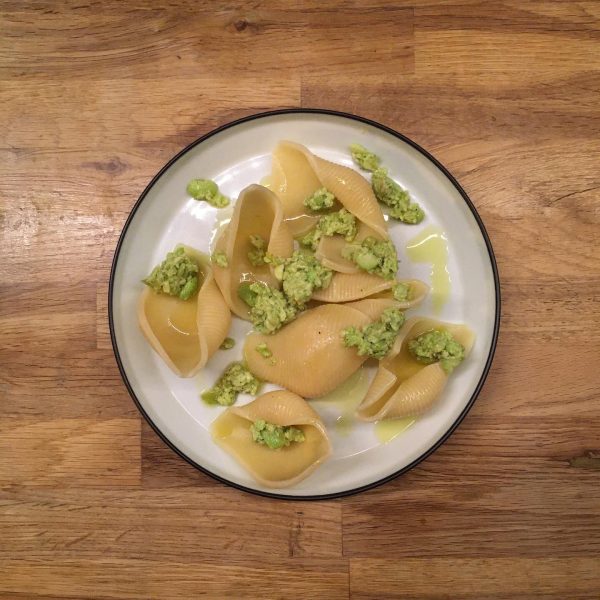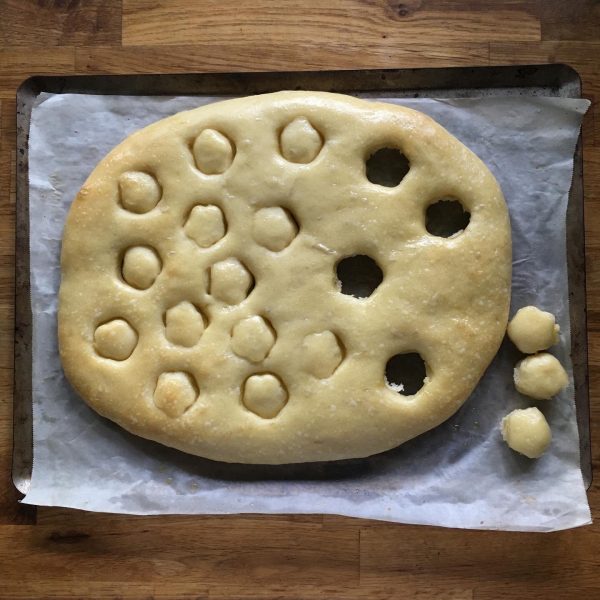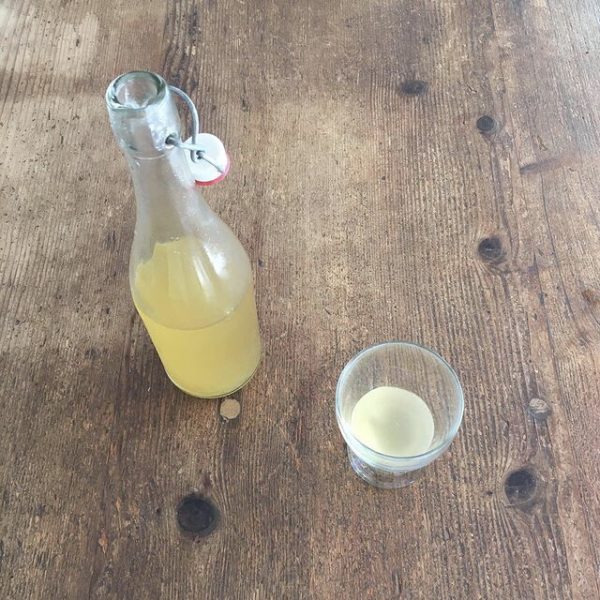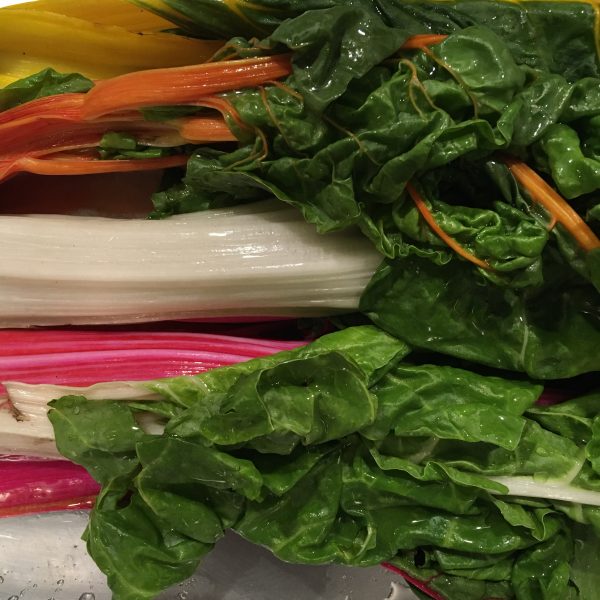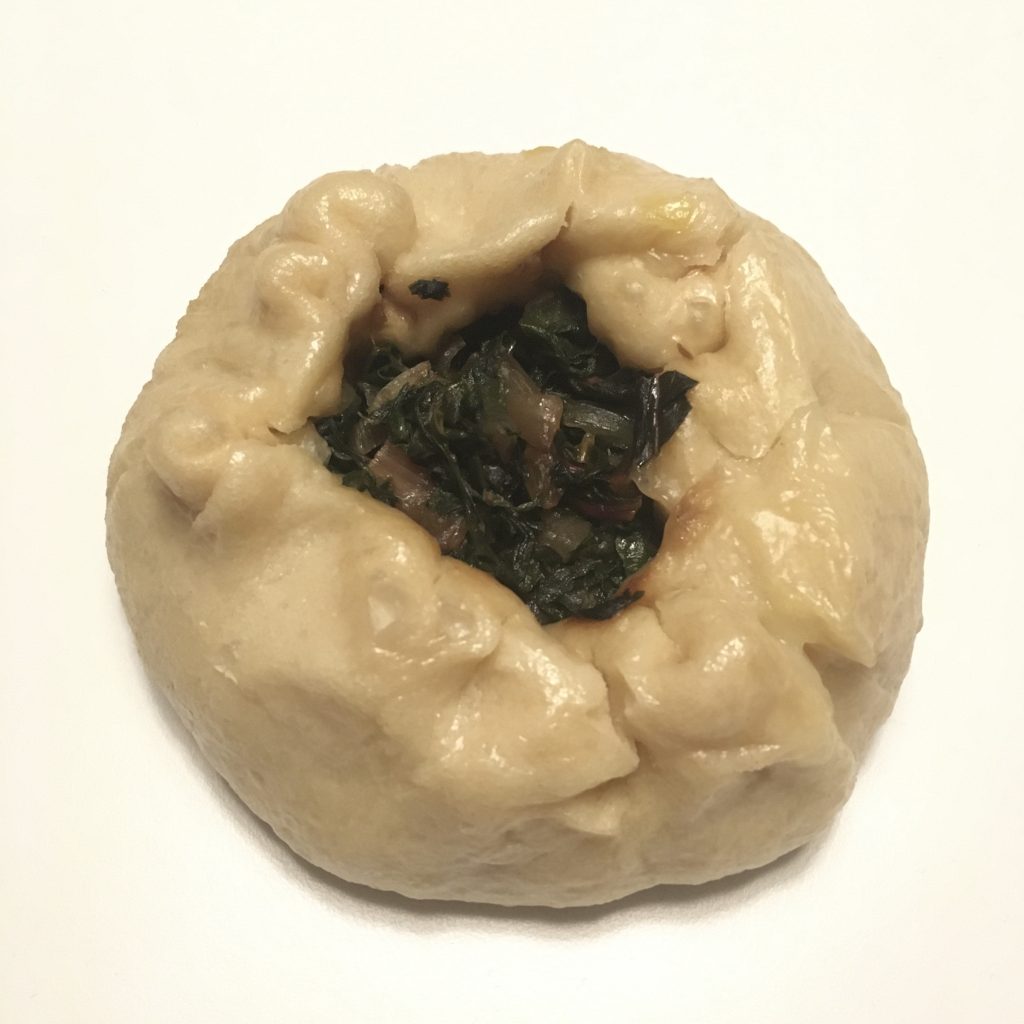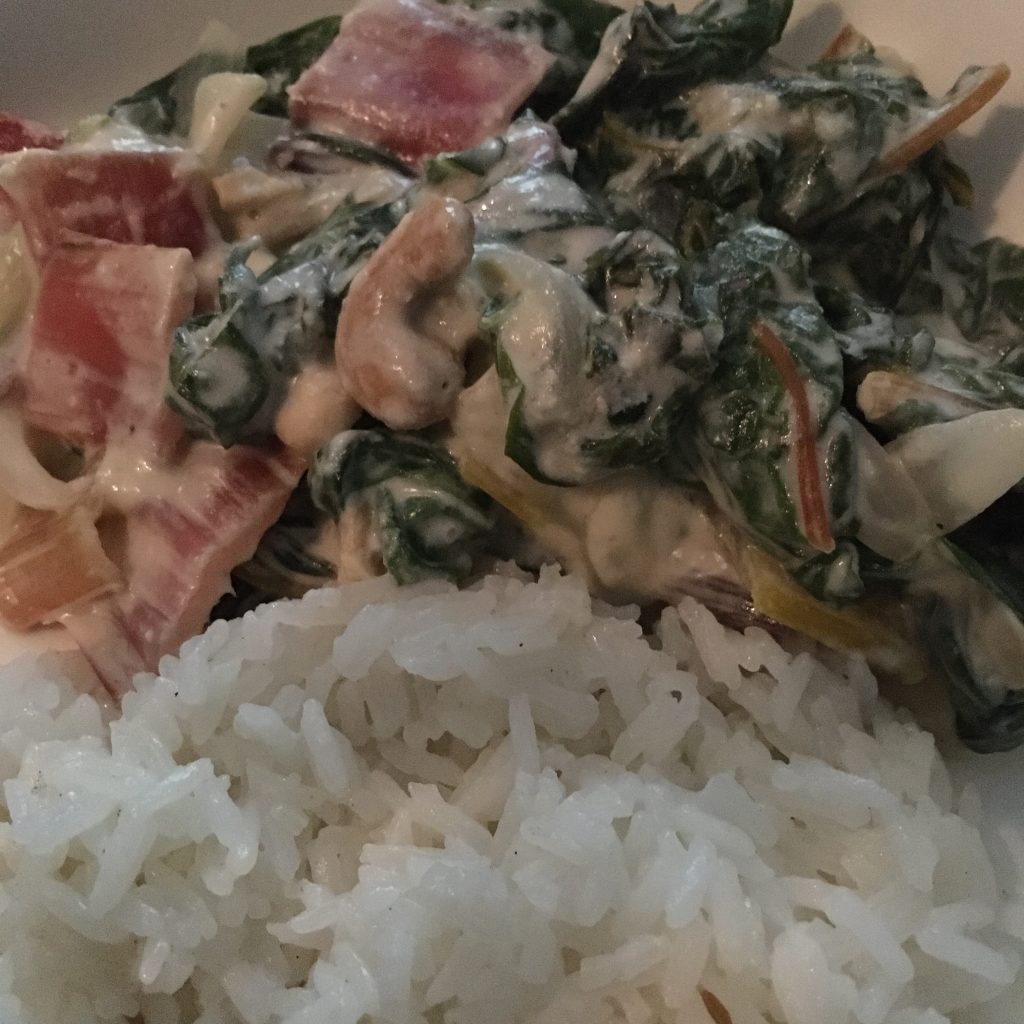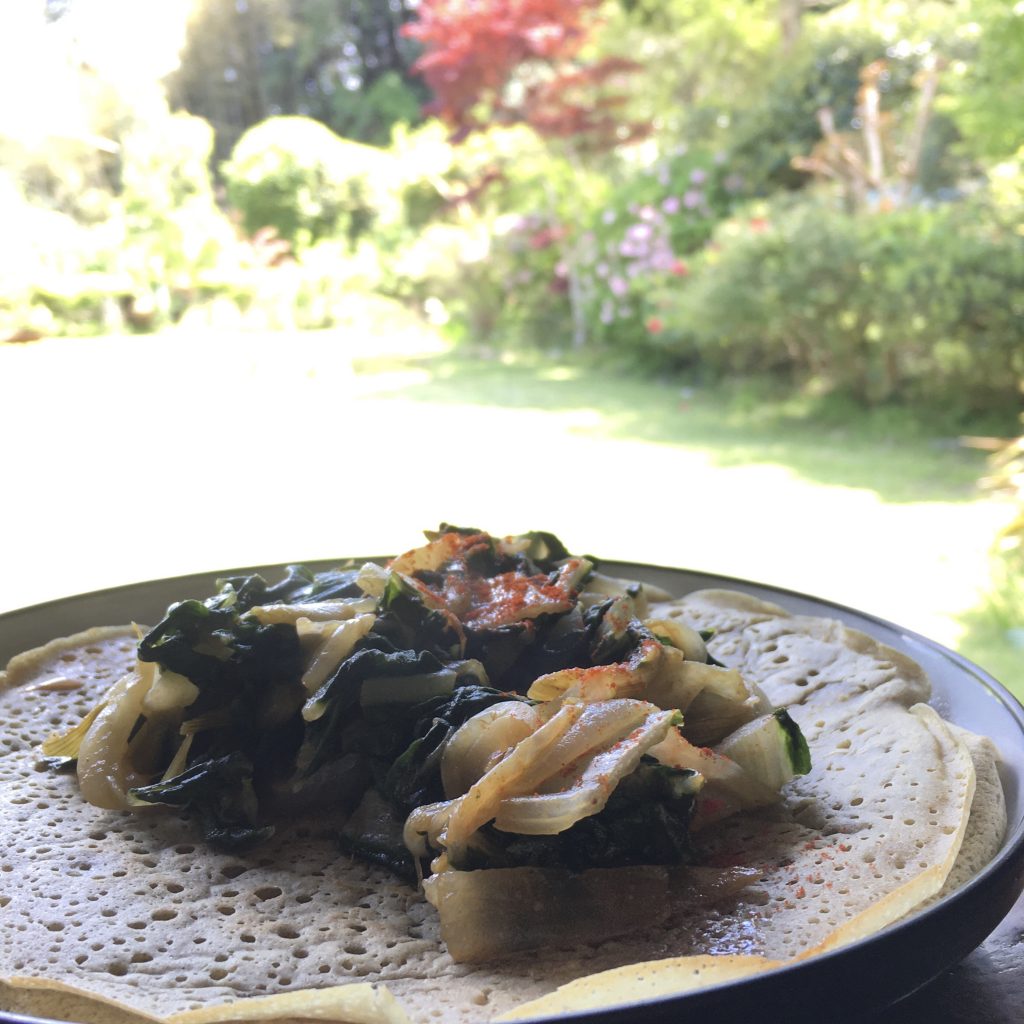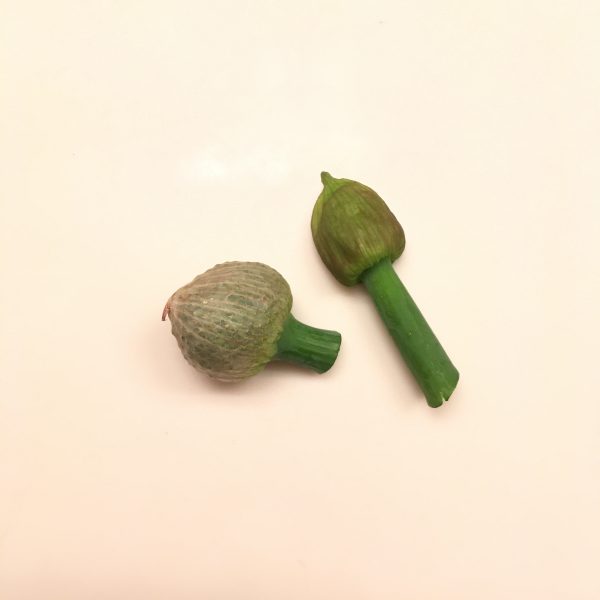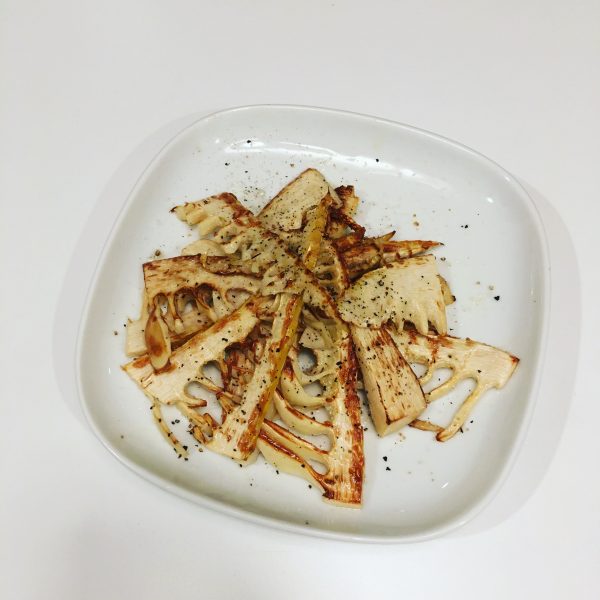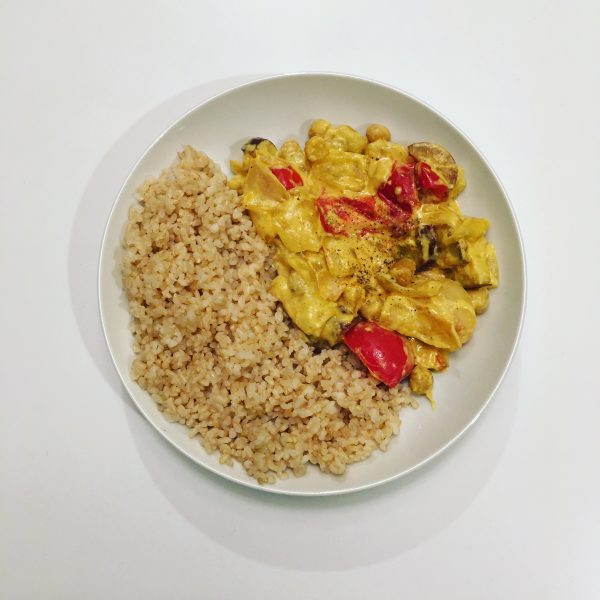The summer is slowly reaching its end and the end of summer vegetables start to arrive such as butternut squash and kabocha, but before the summer ends for real, let’s enjoy a little more the summer vegetables: eggplants, cucumber, edamame and jute mallow…
Fougasse
When I was a child, my mum would come to pick us at school for lunch, then we would walk to the car and somedays, on the way stop to buy some bread at Mr. Richard bread shop. And one bread in particular, fougasse. His signature fougasse unless most other bread shop was not the one with olives, or whatever else you can put in, it was the simplest plain fougasse, and instead of the classic shape it would little hearts cuts and you could pull the little hearts of bread. We lived to eat the little hearts on the way back to the car, and even more when the bread was still warm!!
While fougasse is eaten all year round, I like to have some ready in the summer. It makes the perfect meal with some fresh vegetables and a piece of grilled fish. And it is even more perfect when you have it ready when you get back home after a surfing session at sunset. I love to go surfing on Sunday evening after 17:30, when most day trippers are leaving and you get the ocean for just you, your friends and a couple of regulars. I love driving back home at dusk, seeing the sky becoming purple and the rice paddies turning yellow. And then I am hungry and the fougasse and a fresh cucumber from the garden are waiting to be eaten!

Fougasse
- 250g of flour
- 20g of olive oil plus some for the finish
- 20-30g of sourdough starter
- 8g of salt
- 70g of water (may need adjustment depending on flour and sourdough)
Mix all the ingredients and knead lightly. If the dough is too dry add a bit of water, if too wet a bit of flour. The dough must be rather hard and have not much moisture.
Wait a few hours until it has grown.
Then flatten the ball with the hand and wait 15 minutes. After that, roll the dough with a cooking pin to obtain an oblong shape of about 2-3cm thick. With a shaped cutter of the shape you want, I chose plum because I didn’t have hearts like Mr. Richard’s fougasse, cut a few places with the design you fancy.
Bake at 230deg for 15min or until golden. When out of the oven spread a layer of olive oil with a brush.
Potatoes my friend? Yes, but vitelotte, please!
I have tried many things in the kitchen garden during the past 10 years. Eggplants, cucumbers, snap peas, tomatoes, cabbages etc… most of which were total failures, eaten by the kions, or the snails, or whoever was around. My most successful crop, by far, has been potatoes for a few years now. Except for this year, I tried green peas and that was a big hit… My specialty is actually purple potatoes: vitelottes. I like to grow them and harvest them and I love the color they bring to the plate. And those potatoes are absolutely impossible to find if you don’t grow them (at least for now), so this is why I keep growing some.
This year I grew them in the new kitchen garden. The soil is still under making so the harvest was not as good as I expected, even though I expanded the surface by two, but there were quite enough to make several meals and enjoy their bright color. The way I like to cook them best is simply washed and boiled, then sliced and eaten with other colorful ingredients. Perfect with eggs and cucumbers, dressed with plenty if mustard and olive oil for a classic potato salad, or simply fresh green leaves and tomatoes with olive oil for a fresh and lighter version.
I am quite proud to say that, except the tomatoes and the eggs, all the vegetables and herbs come from the garden. I cannot say that we’re successful with cucumbers but by far the best harvest we’ve ever had, and salad leaves, celery and herbs are doing rather well. The regular potatoes come also from our garden, from a few old potatoes that started growing in the fridge and I decided to plant. I don’t know how you love your potatoes but I’m sure it’s delicious!!!


The mysterious drink you can make at home
OK… after a little time struggling with WordPress I’m back!!!
When I was living with my parents, a long long time ago, my mother always had some kind of homemade preparations such as yogurts, that I was very reluctant to try, and I am still for some reasons not to much tempted by. But when we were at my parents’ place last month, I had a chance to try my mother water kefir. At first I was just wondering what this drink may taste like, and when she told me she only put water, lemon and dry figs in it, and has been drinking every morning for the past few years… I was thinking that I may not die from trying and nothing in it could justify I don’t try. And to be honest I really loved it, and even A. did. So instead of packing tones of tasty cheeses from France I packed a bin of water kefir grains that I smuggled in Japan. (Honestly I don’t know if this is a prohibited product or not… information about water kefir grains are just as scarce as mystic…)
And since we came back, I have been making some every two day or so and we’ve been drinking some every day. I follow strictly my mother recipe but the process of making water kefir is still new to me, and I have been having a lot of questions about it that have been mainly unanswered. This is incredible really to see that such an ancient practice is so little documented, and even the scientific research papers on it are just too little.
The first question that popped to my mind when I was making my first batch was what happens if by mistake I release a kefir grain in the drain and it goes to the river that goes to the ocean… would there be at some point (and kefir grows really quickly) a giant kefir blob on the beach? Am I going to create inadvertently an ecological catastrophe like many have been created. Don’t you know about the terrible taxifolia algae in the Mediterranean sea, escaped from the Monaco aquarium? Or some kind of strange animal like ninja turtles… apparently my mother asked herself the same thing… we couldn’t find any answer… but assuming that water kefir exists for a very long time, if that were to happen, wouldn’t it had happened already?
The second question was, what happens if I drink the liquid and the fermentation is not over. Would that be poisonous? And if by mistake I ingest a grain? Same here, I couldn’t find a clear answer.
But one thing that I learned trying to find information about water kefir according to one paper, is that making water kefir drink industrially seems very difficult. So water kefir can only be made on small batches! Isn’t that amazing?
And the other thing is that the kefir grain composition varies from one place to another. Not totally surprising but interesting… which means probably, like with sourdough, that each one produces a drink with a signature taste!
Mine is very mild and I like it’s refreshing taste and very slightly sparkling. I do not store it in an hermetic bottle to make it more sparkling, nor add any other flavoring such as fruits during the second phase. We just drink it like it is, after the first phase I just filter it. And I prepare it solely with dry fig and lemon, and a bit of sugar, but not too much either, may be that’s why the sparkling is very subtle.
I’m still learning and searching for solid info on kefir, so if you have good resources…
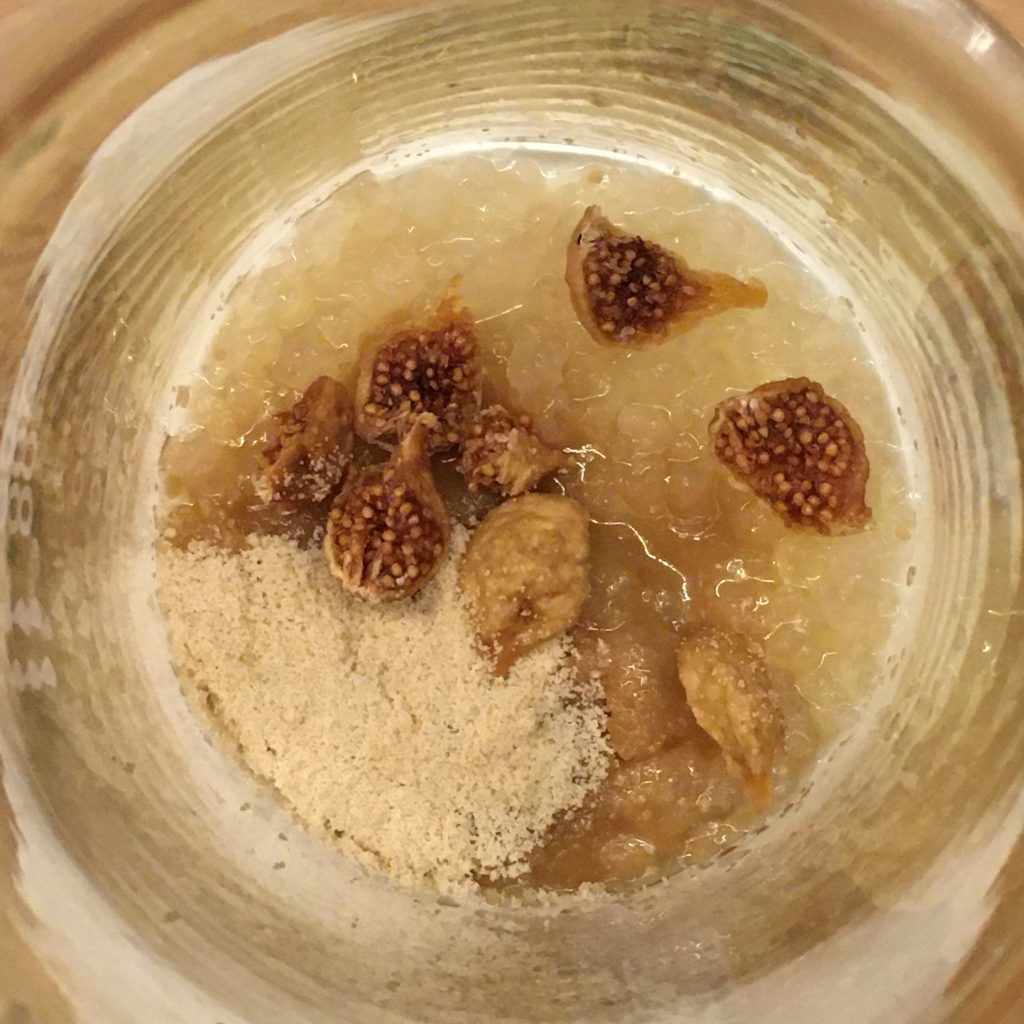
The minimal kitchen
When on travel, eating out for every meal has always been a problem for me. Too much food, too rich, too many ingredients, too much preparation, too far… not enough simple food, not enough traceability… there are so many reasons why I love homemade food… I have been used now for a long long time to making my own food even with the simplest ustensiles and in the most rudimentary kitchens, but for long stays cooking with a kettle, a plate and a knife used for eating, that would be a little too constraining. So when we decided to travel to Paris I had one strong requirement: our hotel room should have a kitchen. We found a place that checked all the boxes finally: the Majestic hotel. The kitchen wasn’t even tiny, with a great opening on the terrace, but minimally equipped: a frypan and a pan. I bought a kitchen knife, a wooden spoon and a bottle of olive oil, and I was ready to cook for 10 days. I need nothing more than that.
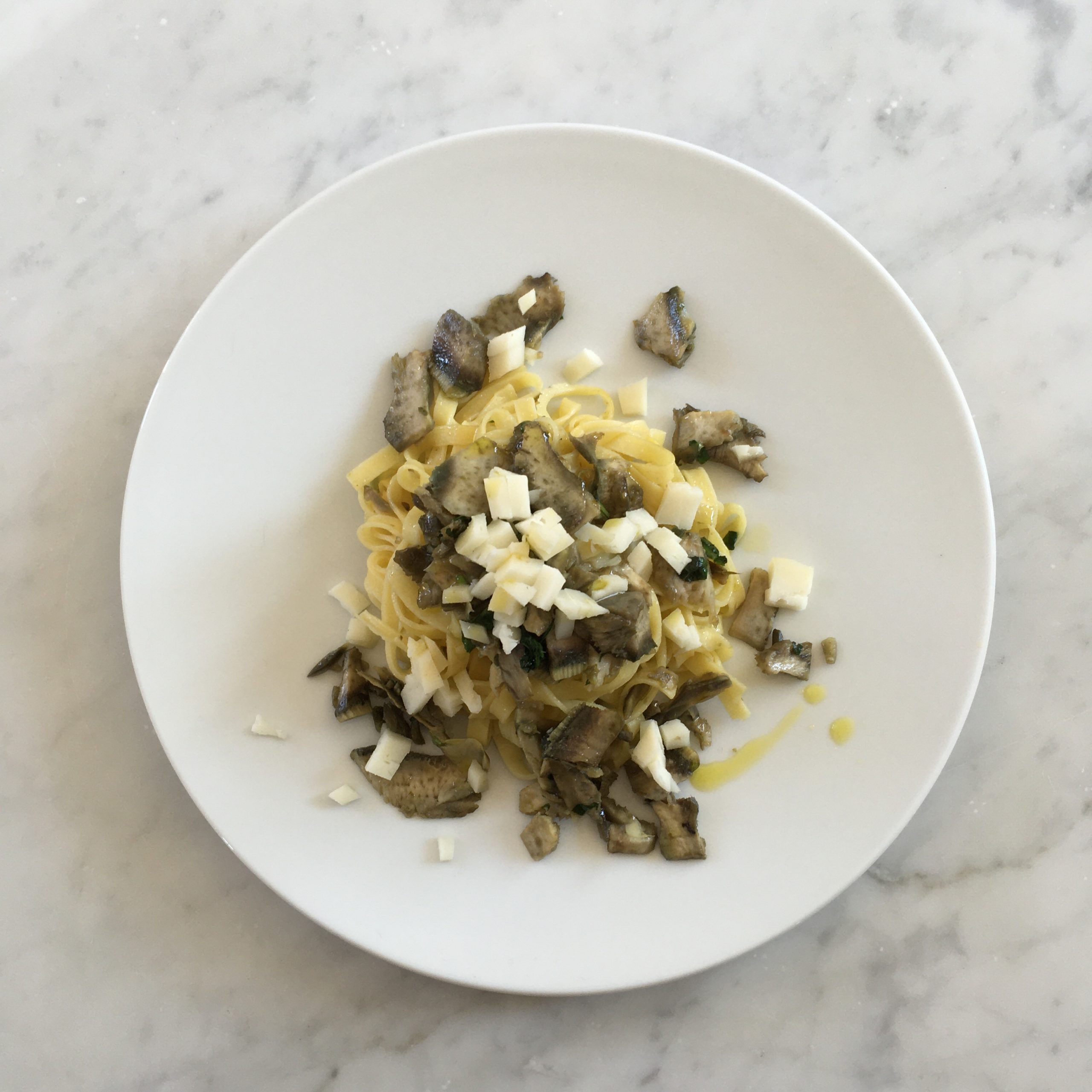
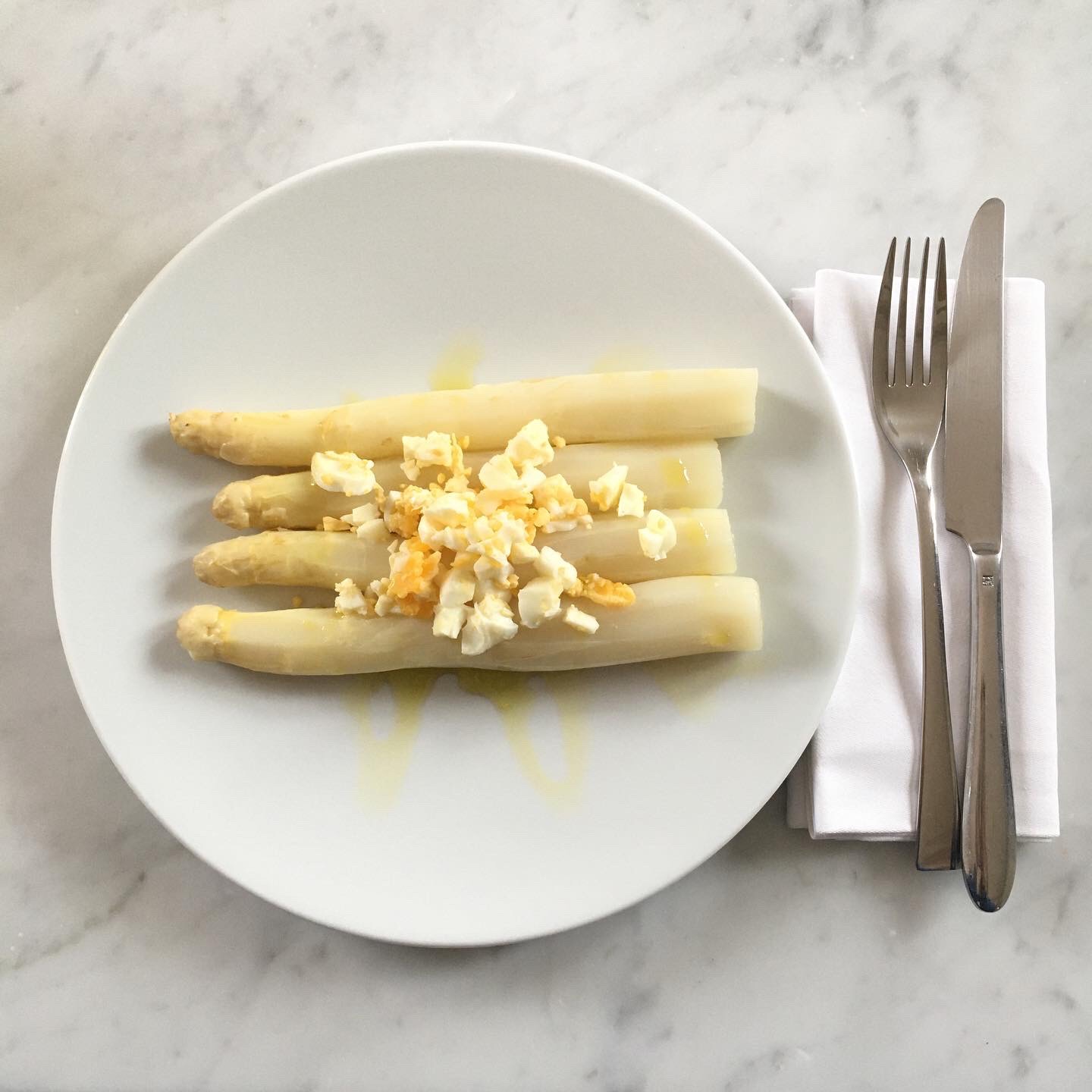
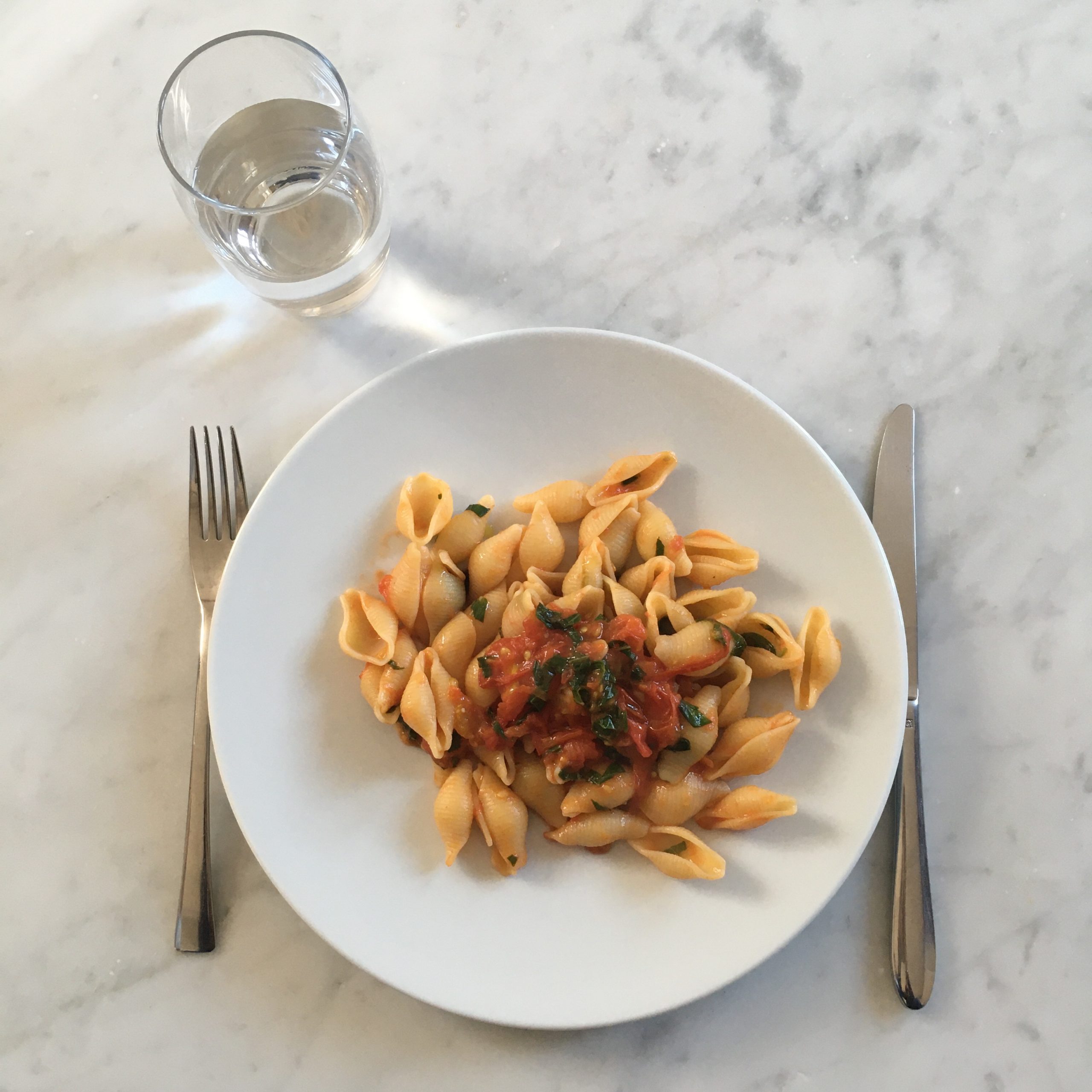

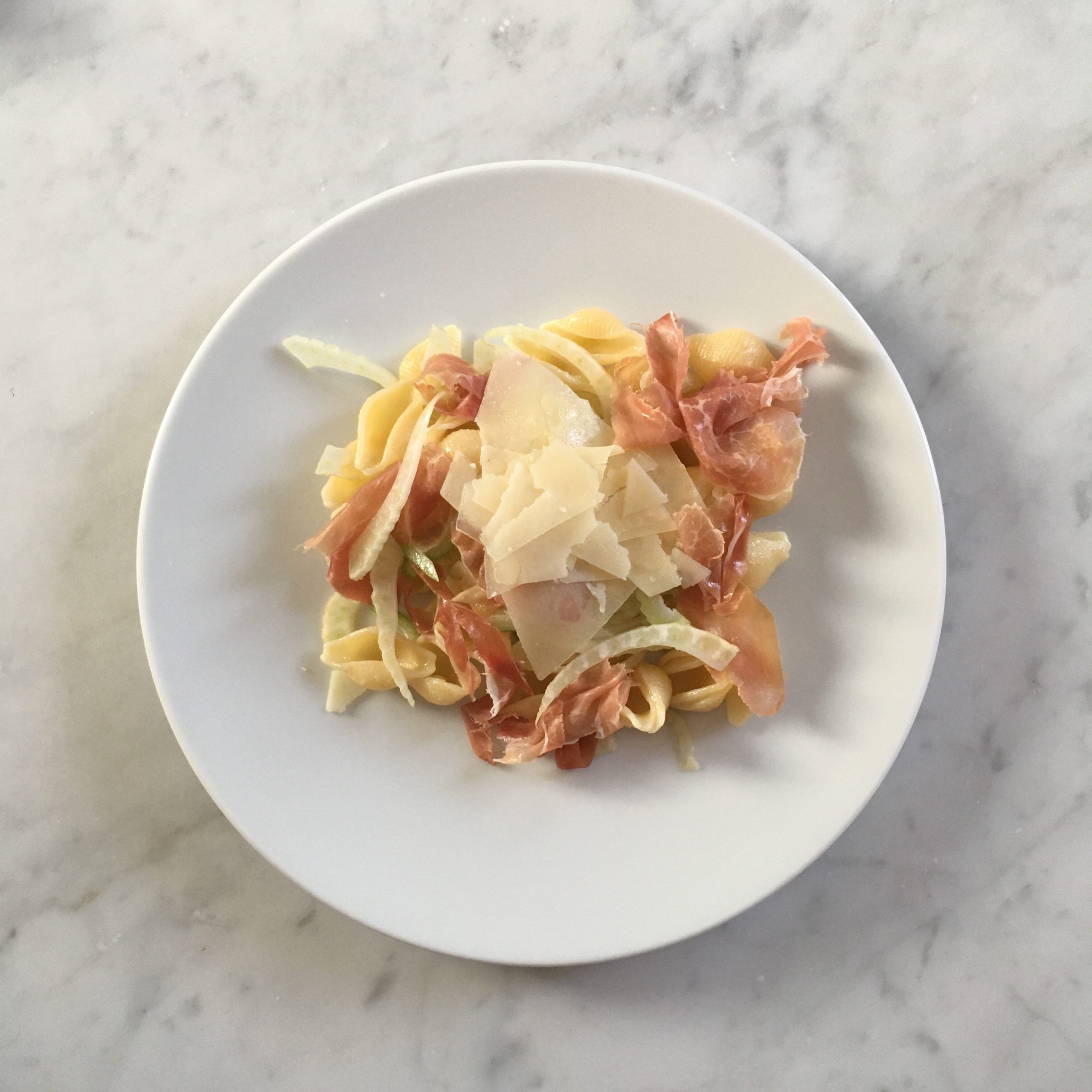
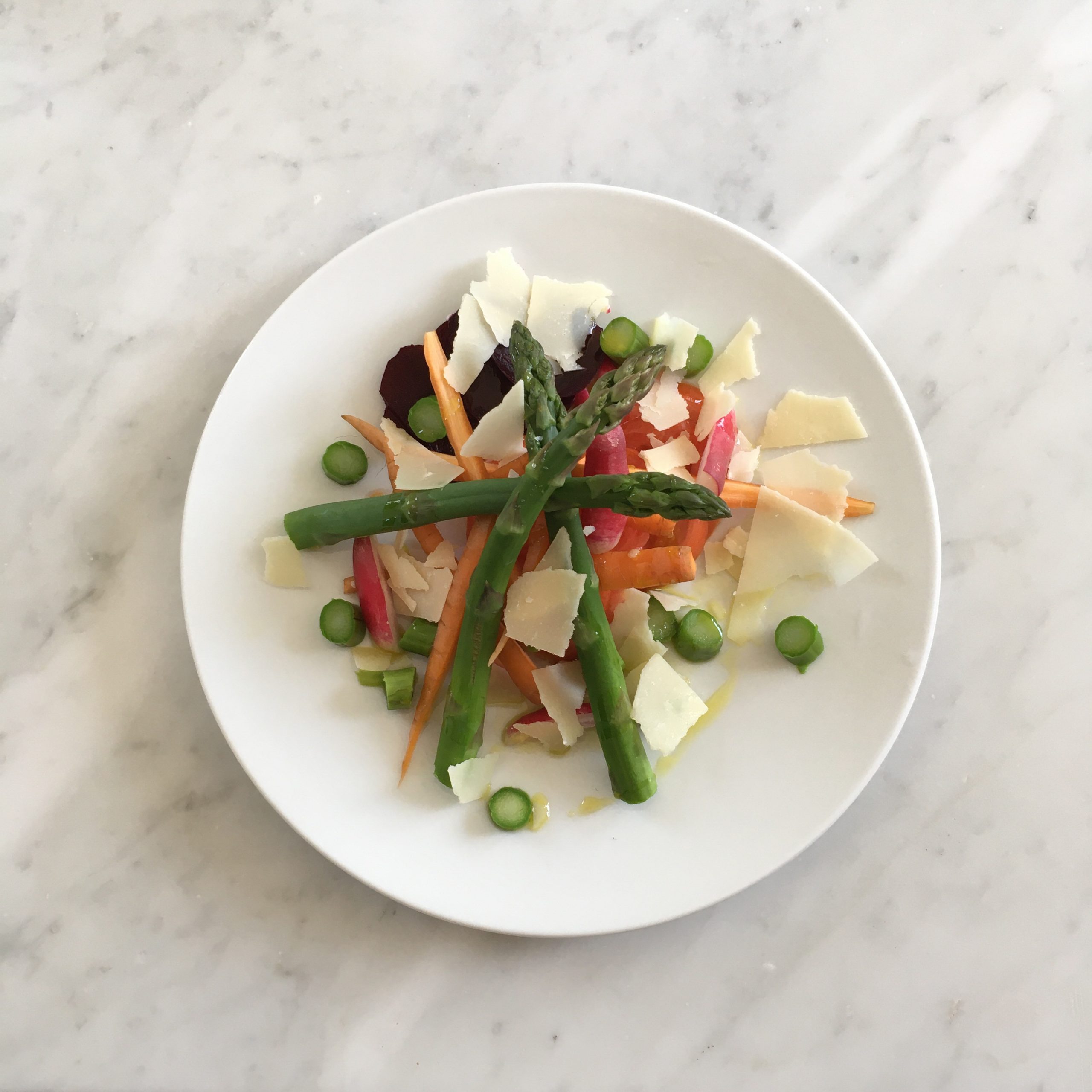
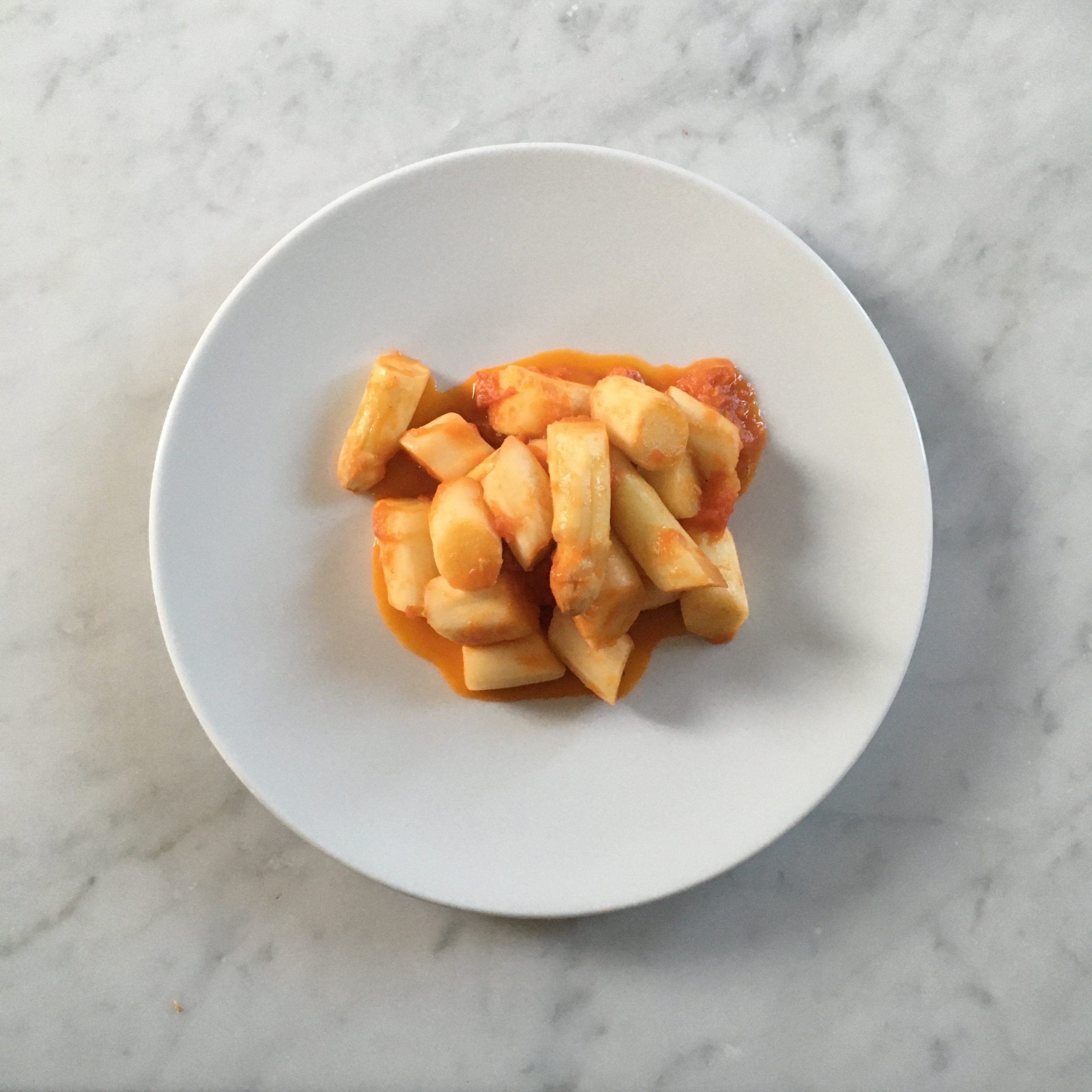
The farmers market down the street on President Wilson Avenue on Wednesdays and Saturdays provided us with all the basic, local and seasonal ingredients we would need. The fish mongers, the cheeses and the organic stalls are really great. For breads there is also a nice stall. You can also find there beautiful flowers, kitchen knives, and a few Italian food stalls, perfect for ravioli and others stuffed pasta. We didn’t test the meat stalls, as I barely cook meat, but there are a few with a nice selection.
May in France is the season for strawberries, the very first cherries, green peas, asparagus, artichokes, new potatoes, new carrots etc… I focused my shopping on products I would usually not eat in Japan. Artichokes and white asparagus definitely were on the top of my list.
Nearby you can also find one of the trending patissier-boulanger shop: Cyril Lignac, which is the first one to open in the area: 7:00AM. With the jet-lag it’s almost too late, but we could manage to postpone breakfast until then and eat fresh pastries for breakfast. I would particularly recommend their pain aux raisins. Extremely delicious.

As a result, I tested some classic recipes and also created a super simple white asparagus recipe that I’d like to share with you.
White asparagus in tomato sauce
- 5 white asparagus/person
- 2 ripe and large tomatoes/person
- 1tbs of olive oil
- A pinch of salt and pepper
Wash and peel the asparagus. Cut in 3cm long chunks. Blanche them. Drain, let cool down and pat dry. In a pan add the olive oil and the diced tomatoes. Cook until it has reduced enough and it becomes a thick tomato sauce. add the cooked asparagus. Stir well and serve. That’s it!!!
Colorful as a Swiss chard
In France we have chards and they are green, with beautiful leafy greens and rather stiff whites. Both are delicious and I have always liked when my mother was making some. Compared to spinach they have a distinctive earthy flavor that I love. It took me a long long time to find chards in Japan. I only found some once we started to shop at local farmers’ markets in Isumi or once in a while at Mitsukoshi Nihonbashi. I think not because of the location but because they are just becoming more popular now and are not originally a green from Asia (we have so many already there…).
What surprised me the most was that instead of being the classic white and green vegetables I knew, they came in various bright and beautiful colors. Vibrant pinks, bright yellows… and the colors stay rather well even after cooking. The other funny fact is that the fibery white part (now colorful part) is a lot less fibery and stiff.
Actually growing some is also not too difficult so we had a try at it last year, and we enjoyed the very young ones not even cooked, just row and they make beautiful salads!
Last weekend on our way to visit some plots of land, we stopped at a local farmer that was selling some. And he gave us a real lot of colorful Swiss chards, and some new onions too. So Swiss chards and new onions have been on our plates pretty much every day. First with some simple pasta and olive oil, then I started to think about other possible recipes. My top 3 of the things I cooked with New onions and Swiss chards is as follow:
1. Steamed buns
2. With coconut milk and cashew nuts, served with spicy Basmati rice
3. With paprika and served with buckwheat pancakes
So here are my recipes. They are all vegan and super easy to make. I hope you’ll enjoy them!
Steamed buns with Swiss chards and new onions (makes 4 large ones)
- a bundle of Swiss chard
- 2 new onions
- a pinch of cumin
- salt and pepper
- 1tbs of olive sesame oil
- 200g of flour
- 1tsp of baking soda
- a pinch of salt
- water
In a bowl mix the flour, baking soda and salt, add water little by little and knead until the dough is soft and smooth. (If you have time, replace the baking soda by sourdough and wait 12h after kneading).
Wash and chop the chards, peal and chop the onion. In a frypan, put the sesame oil, and the chopped vegetables and cook at medium-low heat until they are soft. Add the cumin and salt and pepper and stir well.
Cut the dough in 4, make balls, and roll them into an 18cm disc. Split the filling into 4 portions and put in each disc. Form the buns and steam for 20min. Enjoy with a bit of soya sauce or without!
Swiss chards in coconut milk with super fragrant rice (2 servings)
- a bundle of Swiss chard
- 2 new onions
- 200ml of coconut cream or coconut
- 1 handful of cashew nuts (shelled)
- salt and pepper
- 100g of Basmati rice
- a pinch of cinnamon, of cardamom and coriander, 2 star anises
- A bit of butter if you don’t mind
First, steam the rice with the spices, and the butter if you use some. Then, while it is cooking, wash and cut in chunks the onions and chards. In a pan put the vegetables, the coconut milk and the cashew nuts roughly broken. Cook for 10minutes at medium heat, while stirring once in a while. Then serve with the warm rice and enjoy.
Buckwheat pancakes and Swiss chards and new onion stew (2 servings)
- a bundle of Swiss chard
- 2 new onions
- 1tsp of olive oil
- 1tsp of paprika
- a pinch of turmeric
- salt and paper
- 120g of buckwheat flour
- 1tsp of baking powder
- water
- a bit of oil for cooking the pancakes
In a bowl, mix the buckwheat flour, the baking soda a pinch of salt and add water until the dough is creamy, but not liquid.
Wash and chop the vegetables and cook them in a pan with olive oil while stirring once in a while. Add the turmeric and paprika, salt and pepper and stir again.
In a greased pan cook the pancakes (size is up to you) on both sides. Serve with the vegetables and enjoy.
Et voila, three really easy and delicious recipes with Swiss chard and new onions!
The endless discoveries
There is no need to go far to discover new things and in particular when it comes to food, there is always something new and curious to discover at the farmers market. You just need to look around and you’ll surely find something you haven’t seen before. This time I found negibosu 葱坊主 leek’s flower buds. You can often spot the beautiful flowers in kitchen gardens in the spring, they are amazing ornaments. But I never guessed that would be edible, and that even you would be able to buy them in the bud version at the farmers market. But it is!

So here I am with my negibosu… I thoughts immediately that tempura would be an appropriate recipe. For some reasons, tempura always work well with any green, even with strong flavors: fukinoto is a good example. But what else… and would actually negibosu be strong in flavors? So I browsed a bit the net. Nothing came out neither in French nor in English but for the fully blossomed leek flowers. It was of no help, so I turned to Japanese and bingo! Negibosu have a significant number of entries in cookpad, more than half of them being…
Tempura of course… hum… not helping much either… digging a bit more I finally found the other classic Japanese recipe to accommodate greens: miso ae. Miso ae, in my opinion, works better with creamy miso, the one I have, that I make, is more granular and won’t work as good… one recipe in the end attracted my attention: a goma ae one. So I decided to go for this one, well, my way though. (and the tempura… just in case!!)
So here’s my recipe of goma ae. Suri goma すり胡麻 is ground sesame powder. It’s very easy to make from the sesame seeds, or to buy already powdered.
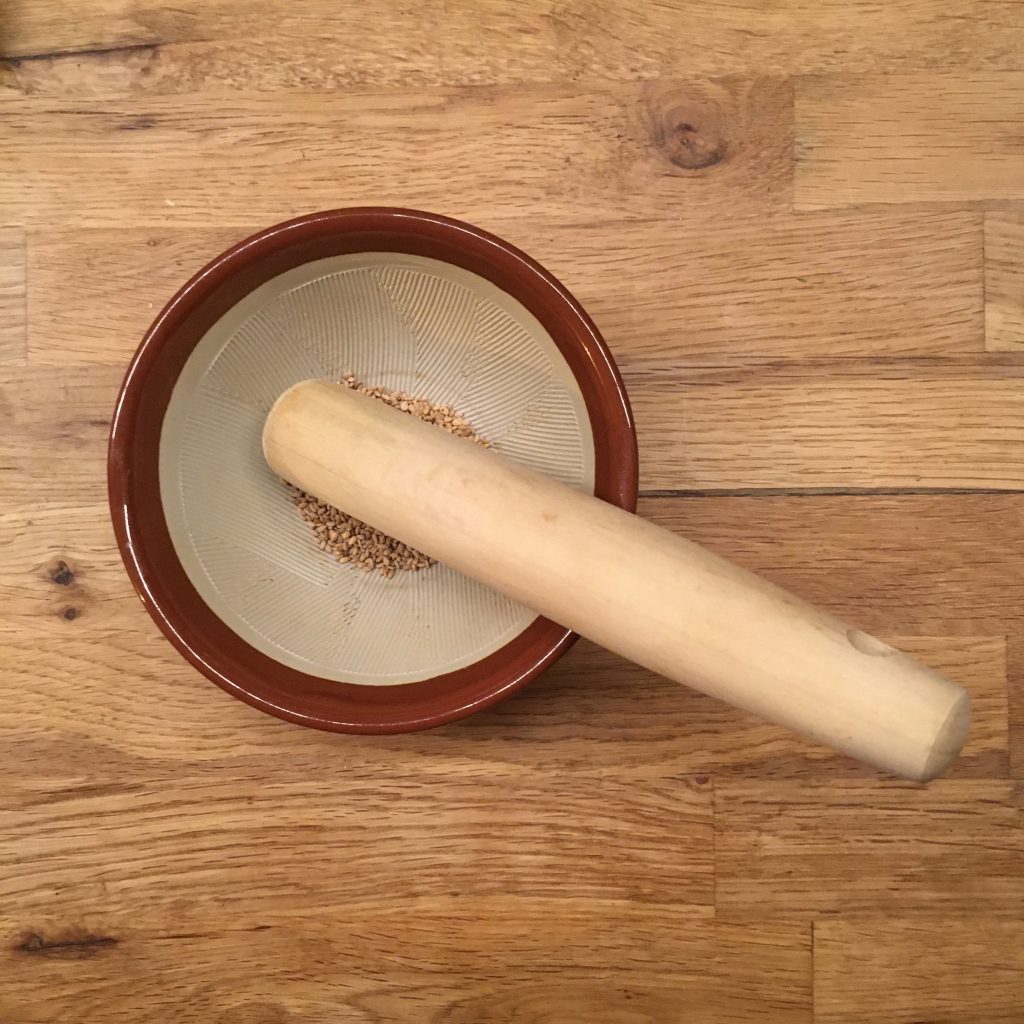
Negibosu goma ae (2 servings)
- A dozen of leek flower buds
- 1tbs of sesame seeds
- 1tbs of soya sauce
- 1tsp of brown sugar
Wash the negibosu, remove the hard part if any, and blanche for a few minutes. Drain and pat dry.
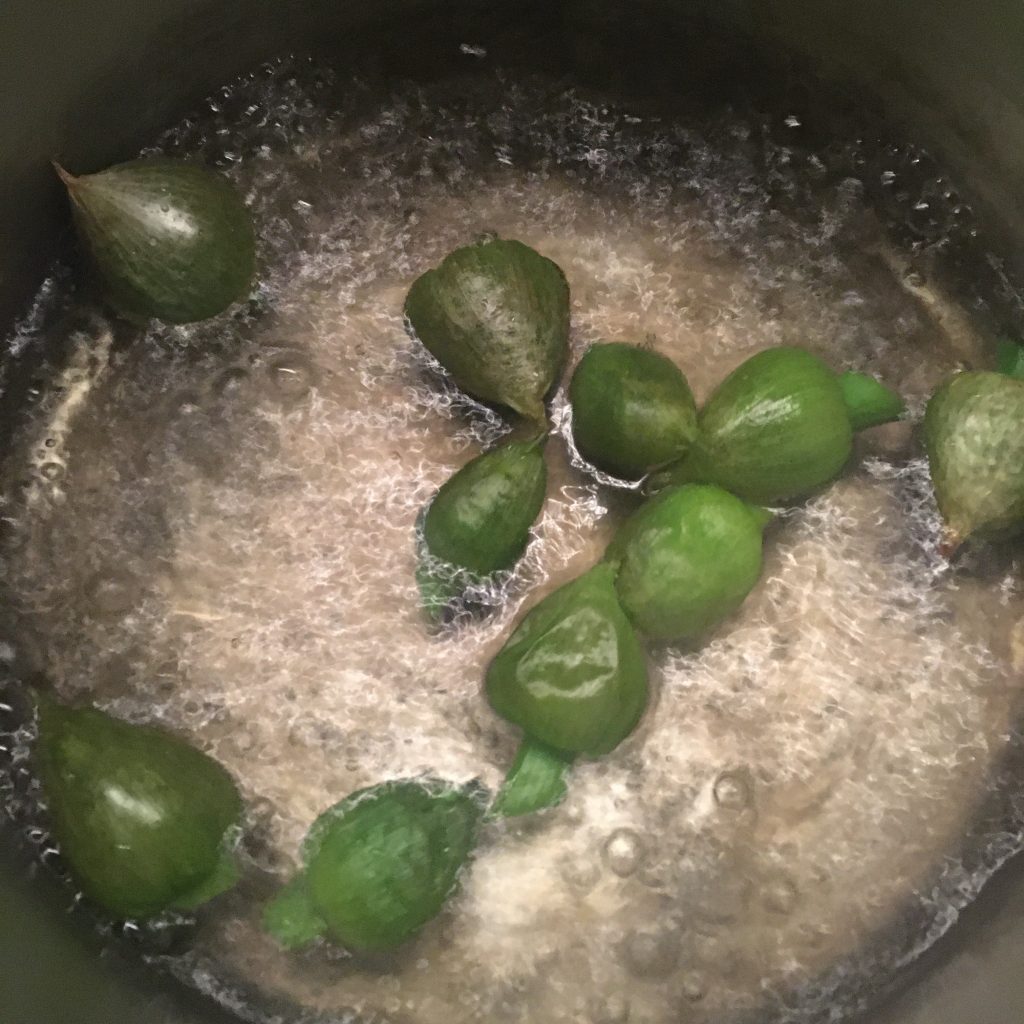
Once cool enough, cut in tiny bite size.
In a mortar, crush the sesame seeds with a pillar to obtain a paste. Add the sugar and soya sauce and stir. Add to the negibosu, stir and that’s ready!! Yes, it’s that simple and you’ll see it’s delicious!!!! Enjoy!
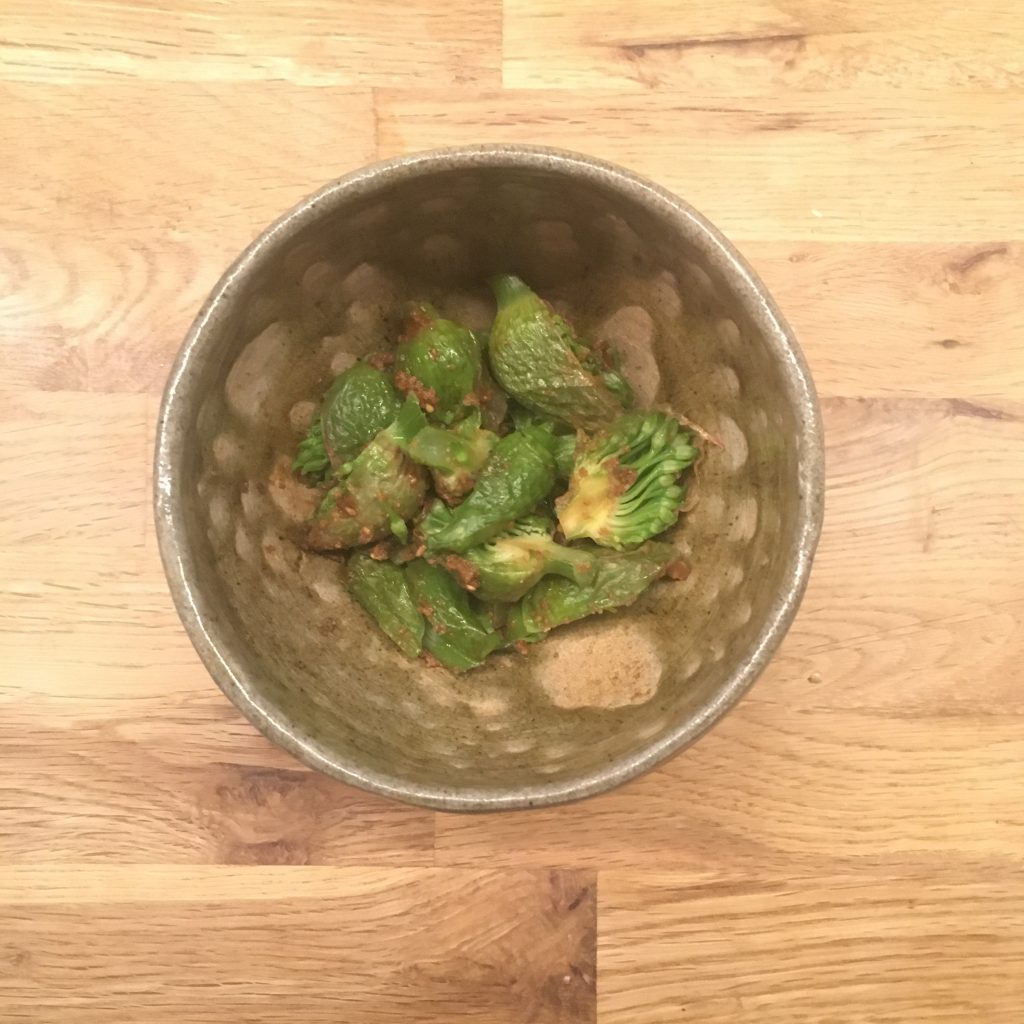
Never tired of bamboo shoots
The season for bamboo shoots in Chiba has started just a few weeks ago… juggling between bad weather, and cold days, we went once to search for some with our neighbors but were not lucky enough to find any. Too early for that side of the area. Probably a few wild boar were also quick enough to come before us and dig to pick their own. But it doesn’t matter, we have friends who have friends who have bamboo shoots. And so I ended up with 2 beautiful shoots. I didn’t have time to prepare them in The country, so I took them with us to Tokyo. What a mess to prepare them in my pocket kitchen! But what a reward to eat them!!! I never regret!
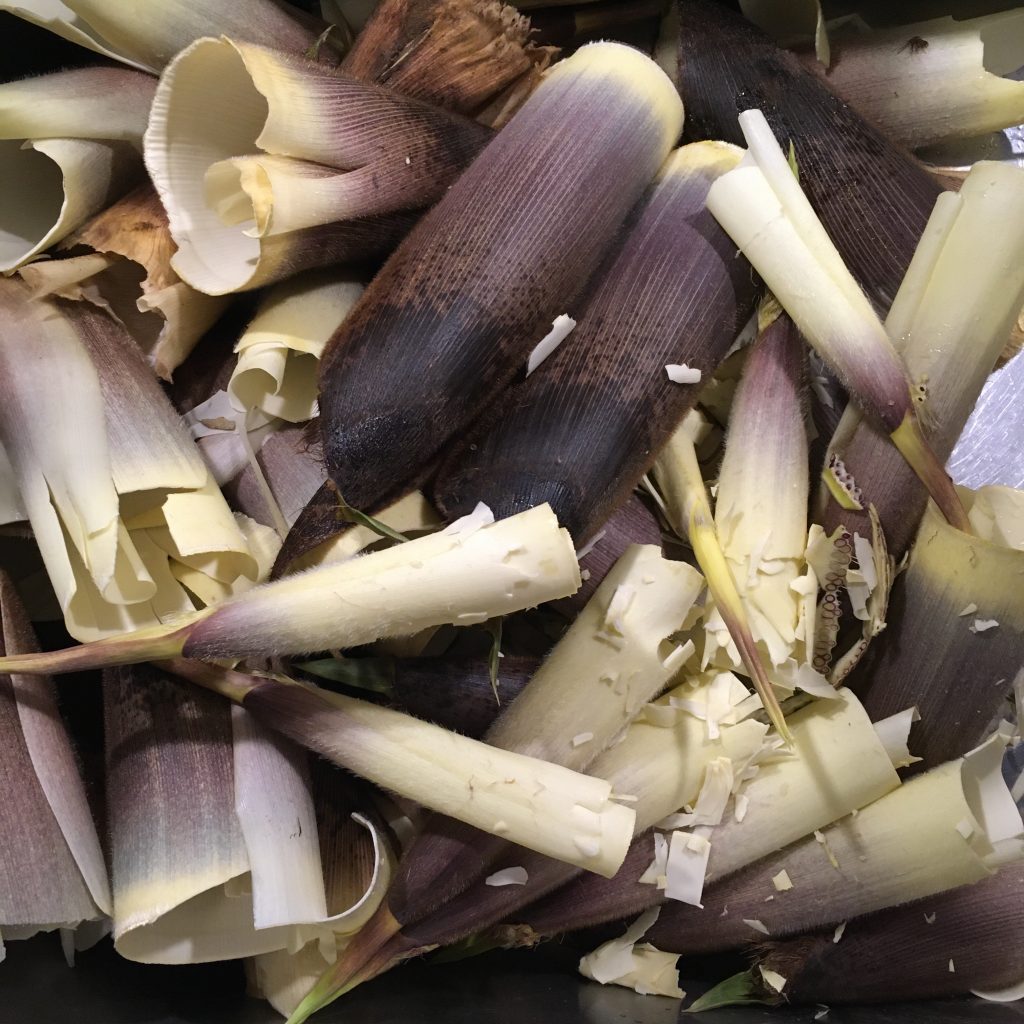
This year, after a classic bamboo shoots rice, back then when my parents were visiting, I decided to go with a few different and more creative recipes. I prepared two different recipes. One is a simple sautéed version. So delicious I had to do a second batch! The second is a recipe of steamed buns. Last year I made eagle fern and bamboos shoot ones, but as I am getting better at making buns, I felt it is worth sharing this one!
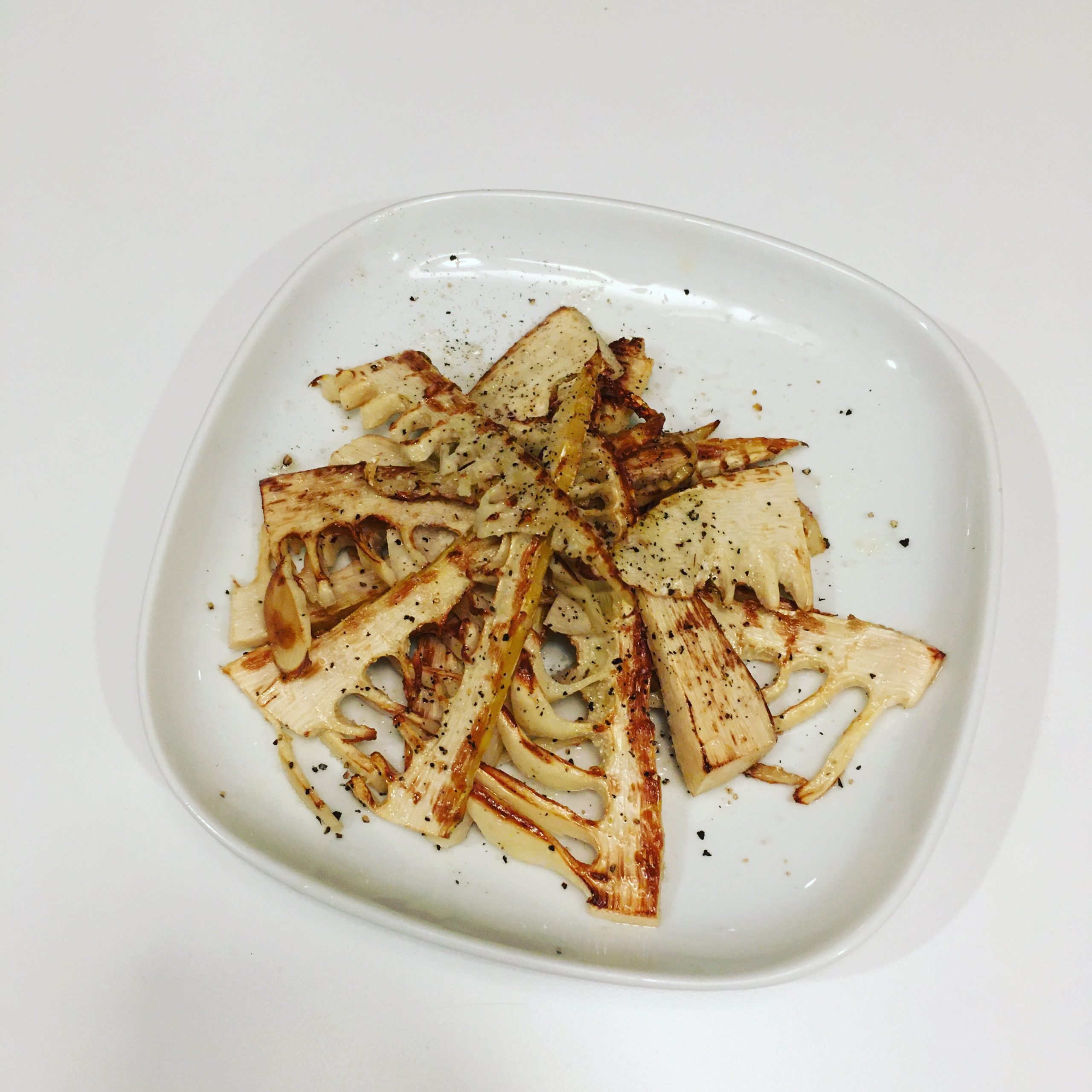
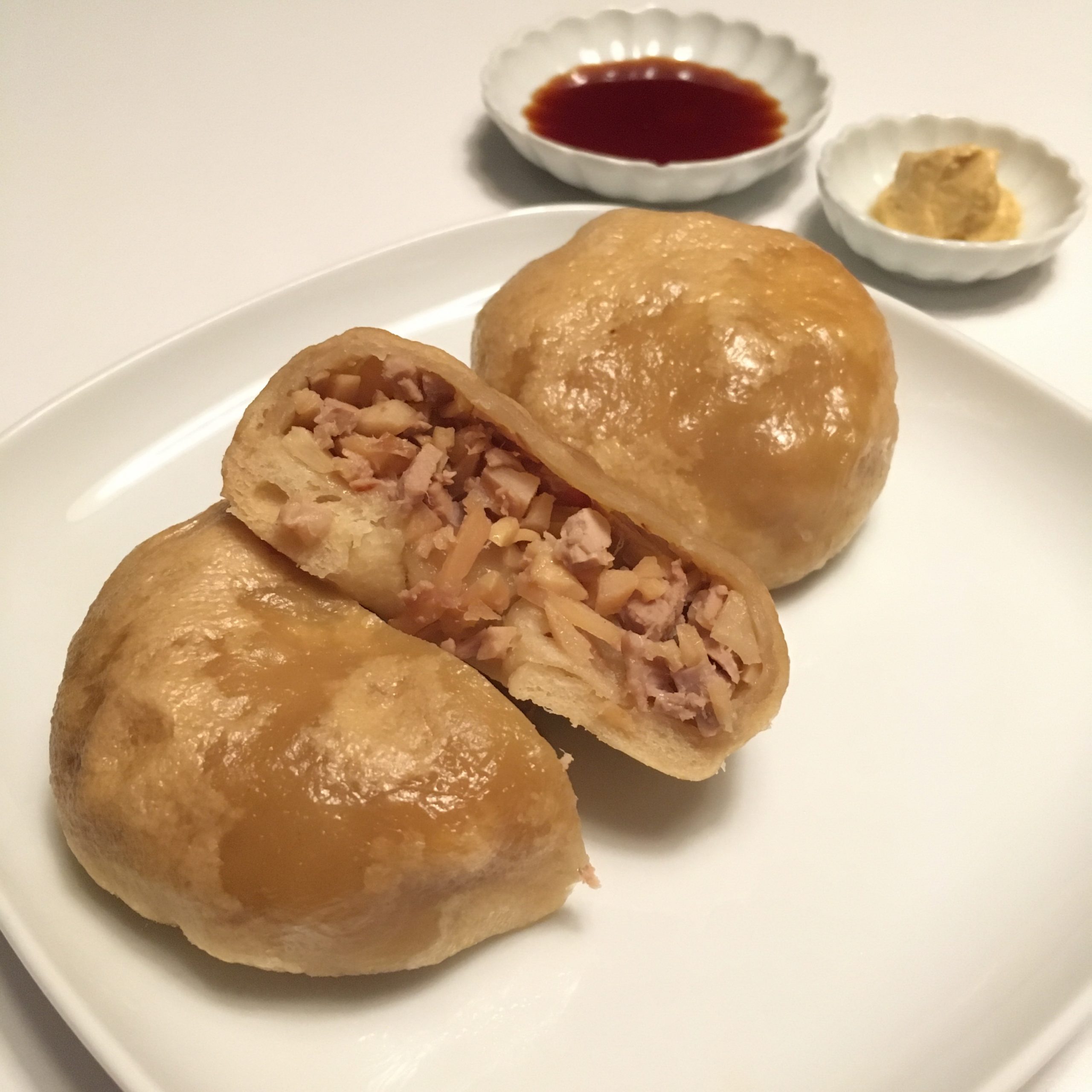
Both recipes assume that you have a parboiled bamboo shoot. For picking and parboiling look at my earlier post here.
Sautéed bamboo shoots
- 1 bamboo shoot fresh and parboiled
- 1tsp of cooking oil
- salt and pepper as you like
Cut the bamboo shoot in 4 vertically. Slice each quarter. In a fry pan heat the oil. The add the shoots sliced. Cook until golden, flip on the other side, cook until golden. Sprinkle salt and ground pepper and serve immediately.
Steamed buns (make 8 small, perfect for 2 people as main)
- 150g of flour
- 1tsp of baking soda
- 1 pinch of salt
- Water
- 1/2 bamboo shoot
- 100g of pork fillet (leftover are perfect)
- Soya sauce
- Mustard
First prepare the dough by mixing the flour, baking soda, salt and add water little by little until obtaining a smooth dough. Put under a wet cloth and let it rest at least 30min. More is better.
Cook the pork filet if not yet cooked. Simply, in a pan with pepper. Then chop finely.
Chop the bamboo shoot in coarse manner. You want chunks to remain as it will bring the contrast between the smooth dough and meat and the crunchy bamboo. However, if too coarse, filling the buns will be hell. So 3-8mm is a good target.
In a bowl mix the chopped bamboo shoot, the pork, add 1tsp of soya sauce and stir well.
Back to the dough now. Cut in 8 pieces. Make balls and roll with a rolling pin into 12-15cm diameter circle. Put a large spoon if filling in and close the dough. I don’t have a very good technique, but it works well when I first fold in two then fold in the orthogonal direction, then I add fold in each quadrant. For this specific recipe instead of cooking them folds up, I flipped them to hold the folds under. Then steam for 15min. Serve with soya sauce and mustard and enjoy!
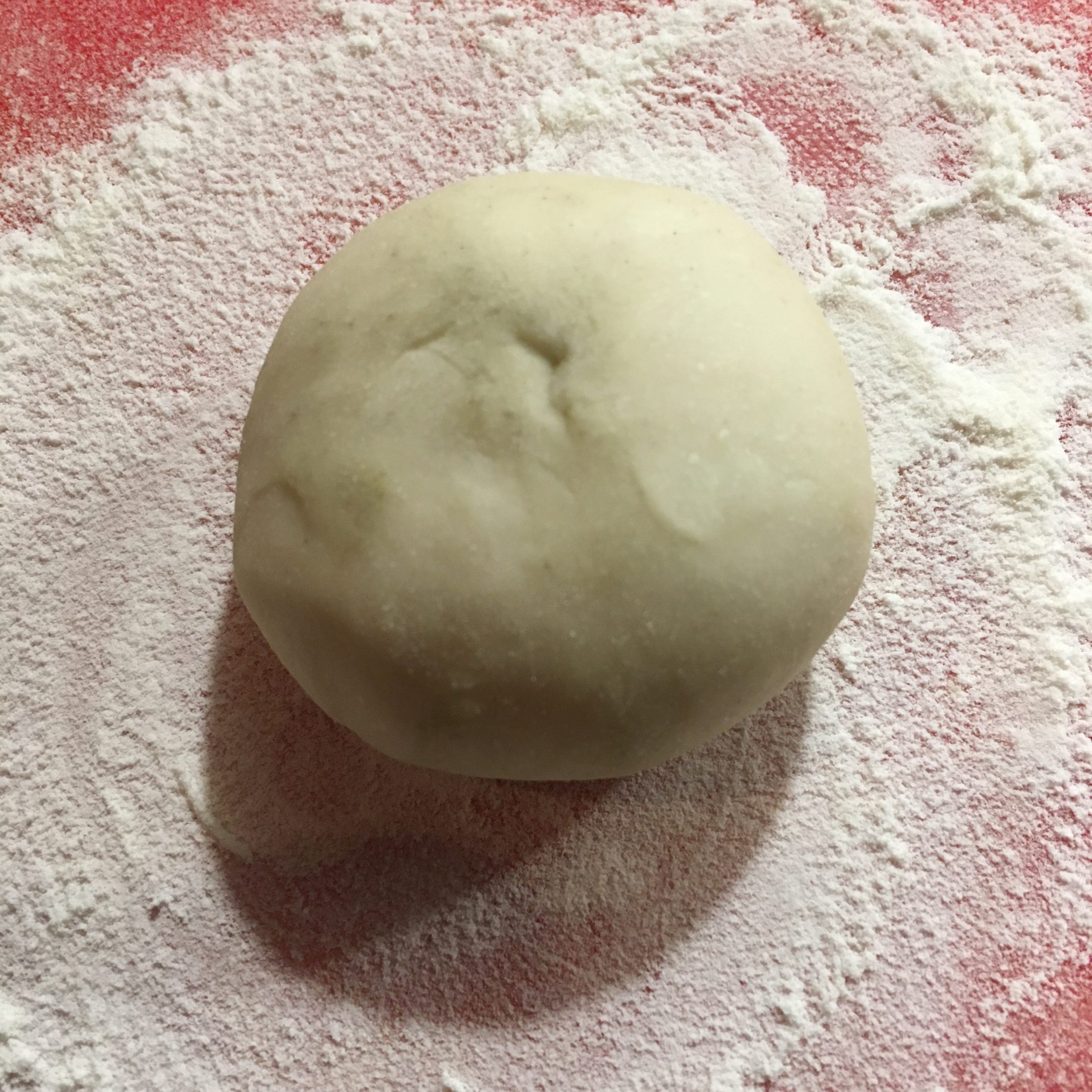

Always the same, never the same
Since we’ve been working from home, I cook three to four meals a day (we wouldn’t miss a good tea time!) and a whole new routine of recipes slowly replaced old habits. More meals to cook = more chances to explore. I cook more quiche as we spend more time in Ohara, I also cook more steam buns and gyoza, also one dish that has been an almost weekly thing is brown rice and spicy vegetables. As much I love Japanese brown rice, it takes too much time to cook it after coming back from work and have it ready for dinner (about 2 to 3h) so I would almost never make any. Working from home as this perk that starting a recipe is really simple, squeezed between two meetings.
For some reason Thursday is the day we most often have brown rice. And one thing I really love is to have it with some seasonal vegetables and a light spicy sauce. Versions are endless. And with the spring coming and the new vegetables I prepared a very simple and ultra full of flavors version. A few chick peas remaining from the hummus I made the other day, a bit of coconut cream, and a lot of new and fresh onions that our friends gave us. Add some super ripe tomatoes and, because winter is still not completely gone, a sweet potato, you have a great base. Normally I would have added curry to the mixture, but curry powder is on my shopping list and I didn’t have time to go grocery shopping this week. And actually it was good that way. It forced me to explore other spice combination and I realize that curry is not necessary. So if you want a very mild and very tasty recipe for your new onions and your brown rice, just read below and enjoy!
New onions with spice and coconut milk
- 2-3 new onions
- 1 sweet potato (one carrot could do, nothing could do too)
- 1 large and ripe tomato (if you can’t find one just do without)
- 200ml of coconut cream or coconut milk
- 1 cup of chick peas, boiled and drained
- 1tsp of ground cardamom
- 1tsp of turmeric
- 1/2tsp of all spice
- 1/2tsp of ground cumin
- 1/2tsp of salt
- ground black pepper
Remove one layer of onion skin and cut them in 8. Wash and cut the vegetables in bite size.
In a greased pan, on medium heat, put all the vegetables, and the chick peas, and cook for 10min while stirring regularly.
Add the coconut cream, the spices and stir well. Cook under cover for 5min. And that’s ready. Serve with brown rice, but I bet it is also a killer with flat breads or basmati rice.
